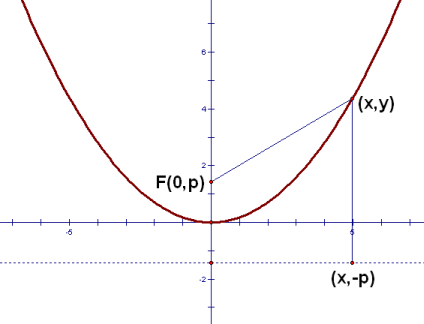 Equations of Simple Parabolas (Part 1)
Equations of Simple Parabolas (Part 1)
(This page is Part 1. Click here for Part 2.)
You may want to review the prior web exercise, Parabolas.
If a parabola is placed in a coordinate plane in a simple way, then a simple equation is obtained.
- Derivation: parabola with vertex at origin, focus on $y$-axis
- Equations of simple parabolas
- Memory Device: ‘one over four pee pairs’
- Shifting the parabola
- Graphing a shifted parabola
Derivation
Place a parabola with its vertex at the origin, as shown below.

-
If we put the focus on the $y$-axis, then the directrix will be parallel to the $x$-axis.
-
Or, if we put the directrix parallel to the $x$-axis, then the focus will be on the $y$-axis.
In either case, let $\,p \ne 0\,$ denote the $y$-value of the focus. Thus, the focus has coordinates $\,(0,p)\,.$
Although the sketch above shows the situation where $\,p\gt 0\,,$ the following derivation also holds for $\,p \lt 0\,.$
Notice that:
| $p\gt 0$ | if and only if | the focus is above the vertex | if and only if | the parabola is concave up (holds water) |
| AND | ||||
| $p\lt 0$ | if and only if | the focus is below the vertex | if and only if | the parabola is concave down (sheds water) |
For example, if the focus is above the vertex, then $\,p\,$ must be greater than zero, and the parabola must be concave up. As a second example, if the parabola is concave down, then $\,p\,$ must be less than zero, and the focus is below the vertex.
Since the vertex is a point on the parabola, the definition of parabola dictates that it must be the same distance from the focus and the directrix.
Thus, the directrix must cross the $y$-axis at $\,-p\,$; indeed, every $y$-value on the directrix equals $\,-p\,.$
Let $\,(x,y)\,$ denote a typical point on the parabola.
The distance from $\,(x,y)\,$ to the focus $\,(0,p)\,$ is found using the distance formula: $$ \tag{1} \cssId{s36}{\sqrt{(x-0)^2 + (y-p)^2 } = \sqrt{x^2 + (y-p)^2}} $$

To find the distance from $\,(x,y)\,$ to the directrix, first drop a perpendicular from $\,(x,y)\,$ to the directrix. This perpendicular intersects the directrix at $\,(x,-p)\,.$ The distance from $\,(x,y)\,$ to the directrix is therefore the distance from $\,(x,y)\,$ to $\,(x,-p)\,$:
$$ \tag{2} \cssId{s40}{\sqrt{(x-x)^2 + ((y-(-p))^2} = \sqrt{(y+p)^2}} $$From the definition of parabola, distances $\,(1)\,$ and $\,(2)\,$ must be equal:
$$ \cssId{s42}{\sqrt{x^2 + (y-p)^2} = \sqrt{(y+p)^2}} $$This equation simplifies considerably, as follows:
| Squaring both sides: | $ x^2 + (y-p)^2 = (y+p)^2 $ |
| Multiplying out: | $ x^2 + y^2 - 2py + p^2 = y^2 + 2py + p^2 $ |
| Subtracting $\,y^2 + p^2\,$ from both sides: | $ x^2 - 2py = 2py $ |
| Adding $\,2py\,$ to both sides: | $ x^2 = 4py $ |
| Dividing by $\,4p\,$ and rearranging: | $ \displaystyle y = \frac{1}{4p} x^2 $ |
Such a beautiful, simple description for our parabola! The most critical thing to notice is the coefficient of $\,x^2\,,$ since it holds the key to locating the focus of the parabola.
As an example, consider the equation $\,y = 5x^2\,.$ Comparing $\,y = 5x^2\,$ with $\,y = \frac1{4p}x^2\,,$ we see that $\, 5 = \frac{1}{4p}\,.$ Solving for $\,p\,$ gives:
| $\displaystyle 5 = \frac{1}{4p}$ | original equation |
| $20p = 1$ | multiply both sides by $\,4p$ |
| $\displaystyle p = \frac{1}{20}$ | divide both sides by $\,20$ |
Thus, $\,y = 5x^2\,$ graphs as a parabola with vertex at the origin, and focus $\,(0,\frac{1}{20})\,.$ So easy!
In summary, we have:
Every equation of the form $\,y= ax^2\,$ (for $\,a\ne0\,$) is a parabola with vertex at the origin, directrix parallel to the $x$-axis, and focus on the $y$-axis.
If $\,a\gt 0\,,$ then the parabola is concave up (holds water).
If $\,a\lt 0\,,$ then the parabola is concave down (sheds water).
If $\,p\,$ denotes the $y$-value of the focus, then $\,a = \frac{1}{4p}\,.$ Solving for $\,p\,$ gives $\, p = \frac{1}{4a}\,,$ and thus the coordinates of the focus are $\,(0,\frac{1}{4a})\,.$
Memory Device: ‘one over four pee pairs’
Notice that if $\,a = \frac{1}{4p}\,,$ then $\,p = \frac{1}{4a}\,.$ Or, if $\,p = \frac{1}{4a}\,,$ then $\,a = \frac{1}{4p}\,.$ What a beautiful symmetric relationship!
Thus, I fondly refer to $\,a\,$ and $\,p\,$ with the catchy phrase: ‘one over four pee pairs’. (Try to say this quickly ten times in a row!)
If you know either $\,a\,$ or $\,p\,,$ then it's easy to find the other—just multiply by $\,4\,$ and then flip (take the reciprocal).
For example, if you know that $\,a = 5\,,$ then $\,p\,$ is found as follows:
-
$4\times 5 = 20\,$ (multiply by $\,4\,$)
-
$p=\frac{1}{20}$ (flip)
Or, if you know that $\,p = \frac{1}{20}\,,$ then $\,a\,$ is found as follows:
-
$4\times \frac{1}{20} = \frac{4}{20} = \frac{1}{5}\,$ (multiply by $\,4\,$)
-
$a = (\text{the reciprocal of } \frac{1}{5}) = 5\,$ (flip)